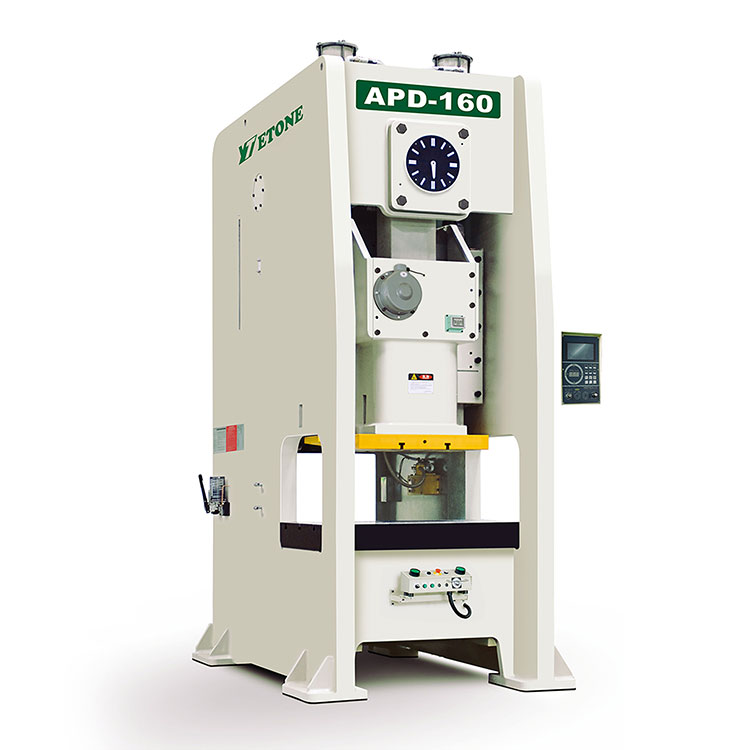Debugging the functions of a straight slide power press requires certain steps to ensure that the functions of the machine work properly. Here are the basic steps for debugging:
1. Check the electrical connection
Power supply check: Make sure that the electric press is connected to the correct power supply, and the voltage and frequency meet the equipment requirements.
Electrical circuit check: Check whether the wires, plugs, switches and control panels are intact, and make sure that the wiring is not loose or aging.
Grounding check: Confirm that the equipment is properly grounded to prevent electrical failures.
2. Check the mechanical parts
Slider check: Make sure that the slider and guide rails are free of foreign matter or contaminants and that they can slide smoothly. The lubrication system of the slider should work properly to avoid wear.
Pressure regulating device check: Check the pressure regulating valve or hydraulic system to ensure that there are no leaks in the system and the pressure setting is normal.
Fastener check: Check the fasteners of all mechanical parts to ensure that they are not loose, especially the various moving parts of the press.
3. Debug the control system
Set the pressure value: Adjust the pressure setting of the electric press according to the needs of the product. Usually, the control panel of the press will have a pressure setting option, which is adjusted according to the required pressure.
Set the stroke and speed: adjust the stroke and movement speed of the slider to ensure that the slider can move according to the set stroke and the speed is stable.
Adjust the working mode: The straight slide power press usually has multiple working modes, such as manual mode, automatic mode, etc. Adjust to the appropriate working mode according to actual use needs.
Adjust the protection device: Check and adjust the protection functions such as overload protection and limit switch to ensure that the equipment can be powered off in time when an abnormality occurs.
4. Perform no-load operation test
No-load start: Start the electric press for no-load test, observe whether the movement of the slider is smooth, and check whether the running status, noise and vibration of the motor are normal.
Check various displays and indicator lights: Ensure that the working status, pressure, speed and other information of the equipment can be displayed correctly, and all indicator lights, alarms and other functions are normal.
Check the oil system (if it is hydraulically driven): If it is hydraulically driven, check whether the hydraulic oil is smooth and whether the oil pump is working properly when starting.
5. Loading test
Loading test piece: Put the workpiece to be processed into the press for testing. Observe the actual working conditions of the press to ensure that the set pressure and speed meet the processing requirements.
Monitor equipment performance: Check the working stability of the press under load, pressure stability, accuracy of the slider movement, and whether there is abnormal vibration or overheating.
6. Adjust the feedback system
Accuracy calibration: If the press has accuracy requirements, perform accuracy calibration to ensure that the stroke and pressure of the slider meet the process requirements. You can use tools such as micrometers and pressure sensors to perform accuracy tests.
Adjust the stroke and pressure feedback system: If the press is equipped with an automatic control system, ensure that the feedback system works properly. Check whether the feedback signals of the sensor and servo motor are accurate.
7. Perform safety inspection
Safety device inspection: Ensure that all safety protection devices such as emergency stop switches and limit switches work properly.
Emergency stop test: Test the emergency stop function to ensure that the operator can stop the equipment immediately in an emergency.
Safety warning signs: Check whether the safety warning signs on the equipment are clear and visible to remind the operator to pay attention to safe operation.
8. Record debugging data
Record all parameters adjusted during debugging and test results, including pressure, stroke, speed and other data, for subsequent reference.
If the equipment is equipped with a data logger or PLC system, ensure that all parameters are correctly recorded.
9. Comprehensive inspection and summary
Check the operating status of the entire equipment to ensure that there is no oil leakage, leakage, overheating and other phenomena.
According to the debugging situation, confirm that the equipment meets the predetermined performance standards and is ready to be put into formal production.
Summary:The key to debugging a straight slide power press is to carefully check the electrical system, mechanical system and control system to ensure that all parameters are set accurately and the machine can operate in a safe and stable state. In particular, the pressure and stroke adjustments must be accurate to ensure the processing accuracy and product quality during the production process. Before officially putting it into production, perform multiple no-load and load tests to ensure that the equipment fully meets the operating requirements.
If you encounter difficulties during the debugging process, it is recommended to contact professional technicians for inspection and adjustment.
